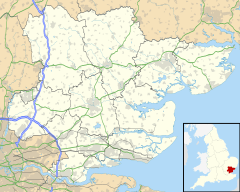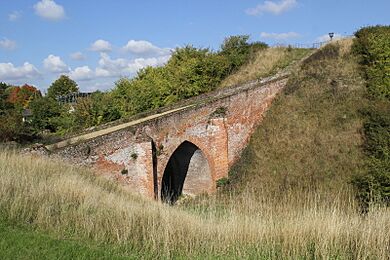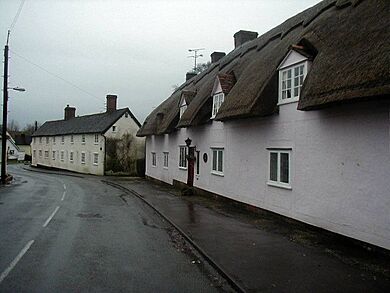Pleshey facts for kids
Quick facts for kids Pleshey |
|
|---|---|
 Holy Trinity Church, Pleshey (Photo taken from Holy Trinity Church Facebook page) |
|
| Population | 373 (2011) |
| OS grid reference | TL665145 |
| District | |
| Shire county | |
| Region | |
| Country | England |
| Sovereign state | United Kingdom |
| Post town | Chelmsford |
| Postcode district | CM3 |
| Dialling code | 01245 |
| Police | Essex |
| Fire | Essex |
| Ambulance | East of England |
| EU Parliament | East of England |
| UK Parliament |
|
Pleshey is a small, old village in Essex, England. It's about 10 kilometers (6 miles) north-west of Chelmsford. Long ago, the Normans built a special type of castle here. It was a "motte-and-bailey" castle, which means it had a big earth mound with a tower. This mound is one of the biggest in Great Britain! The castle was involved in many fights and rebellions in the 1200s.
Contents
Pleshey's Past: A Look at Its History
Who Owned Pleshey Castle?
After William the Conqueror took over England, he gave Pleshey to a powerful man named Geoffrey de Mandeville. Geoffrey built his main home and office here. It was the center for all the other villages the king gave him in Essex. Later, Geoffrey's grandson, also named Geoffrey, became the first Earl of Essex. This title was given to him by King Stephen.
Pleshey Castle became very important in English history. Over time, it passed to the de Bohun family. Henry de Bohun, 1st Earl of Hereford and his wife, Maud, inherited it. Their son, Humphrey, became the Earl of Essex in 1236. Many generations of the de Bohun family lived at Pleshey.
Royal Connections and Rebellions
One famous resident was Humphrey de Bohun VIII. In 1302, he married Elizabeth, who was the daughter of King Edward I. Some of their children were born right here in Pleshey. Sadly, Humphrey VIII was killed in 1322 during a rebellion against King Edward II.
After Humphrey VIII died, his oldest son, John, took over Pleshey Castle. He became the Earl of Hereford and Essex. When John died without children, the castle went to his brother, Humphrey IX.
Another brother, William, became a great military leader. He helped England win important battles during the early Hundred Years War. These included the Battle of Crecy in 1346.
The Castle's Last Heirs
Humphrey IX never married. So, in 1361, Pleshey was inherited by William's son, Humphrey X. He was the last male heir of this family line. Humphrey X died in 1373, leaving only two young daughters, Eleanor and Mary.
Between 1361 and 1384, some religious scholars created special books at Pleshey Castle. One of these books, a Psalter, celebrated Mary de Bohun's marriage. She married Henry Bolingbroke, who later became King Henry IV. Mary was the mother of Henry V, who was famous for the Battle of Agincourt.
Pleshey in Shakespeare's Play
Later, Pleshey Castle passed to Thomas of Woodstock, the youngest son of King Edward III. He was the Duke of Gloucester. His nephew, King Richard II, was angry with him. Richard II had his uncle arrested at Pleshey and sent to France. Two years later, another duke was brought to Pleshey Castle and executed for plotting against the king.
Pleshey Castle is even mentioned in Shakespeare's play Richard II. In the play, Thomas of Woodstock's widow talks about the castle:
- Bid him – O, what?
- With all good speed at Plashy [sic] visit me.
- Alack, and what shall good old York there see,
- But empty lodgings and unfurnished walls,
- Unpeopled offices, untrodden stones?
This shows that by Shakespeare's time, the castle was already falling apart.
Pleshey Castle: A Norman Stronghold
Building the Castle
We know Pleshey Castle existed by 1143. But digging by archaeologists shows it was likely finished between 1096 and 1106. It was a "motte-and-bailey" castle. This means it had a tall, man-made hill called a motte. On top of the motte was a wooden fence (palisade) and a tower. Around the motte were two large yards called baileys. The castle was also surrounded by a ditch filled with water, called a moat.
You can still see the earth mounds of the motte and the south bailey today. They are very well preserved. The shape of the north bailey can still be seen in the curved streets of the modern village.
The motte at Pleshey was built around 1100. It is about 15 meters (50 feet) high. It is one of the biggest mottes in England! The castle's earthworks are still in good shape because they were never rebuilt with stone.
Changes Over Time
In 1158, the castle was taken apart. But it was rebuilt in 1167 by William II de Mandeville. He followed the same plan but made the wall around the south bailey much bigger.
During a civil war in 1215, Pleshey Castle was captured by the king's army. Then, rebels took it back. Both times, the castle gave up without a long fight. This showed it wasn't strong enough against big attacks anymore. So, in 1227, it became the main home for the de Bohun family.
What Archaeologists Found
Archaeological digs have found many parts of the castle. They found a chapel, a great hall with a kitchen, and storage rooms. There were also large private rooms for important guests. A stone gatehouse was found at the south end of the bridge. The room above the gatehouse was called the Queen's chamber. These buildings were likely finished in the late 1300s by the de Bohuns and Thomas of Woodstock.
The main hall of the castle's keep (the strongest part) has also been found. Other rooms might have been "en suite" accommodations, meaning they had their own fireplace and toilet. The best room was probably for the lord and lady of the castle.
By the mid-1400s, the great hall was called the "stranger's hall." This suggests it was used for guests. The castle might have had another main hall in the south bailey.
The last big update to the keep was in 1458-1459. This was ordered by Margaret of Anjou, the wife of King Henry VI. The keep was mostly built from wood, then covered with flint and brick. The brick bridge over the moat was built between 1477 and 1480.
The Castle's Decline
Pleshey Castle slowly fell apart by the mid-1500s. The motte was even used as a rabbit farm! The brick bridge is still there today because it was needed to get to the rabbit farm.
Queen Elizabeth I sold the castle in 1559. Most of its stone was taken apart in 1629 to be used for other buildings. Now, only the earth mounds of the motte and outer baileys remain.
Pleshey Village Today
Pleshey village used to be mainly a farming community. But now, many people who live here travel to work in nearby towns. The village still has a hall, a playing field, a tennis court, and a children's play area. However, the local shop and post office have closed.
The village and castle are very pretty, so many visitors come, especially in the summer. Pleshey is also home to the Chelmsford Diocesan House of Retreat. This is a quiet place for spiritual reflection. It was started in 1927 in an old convent.
The local church, Holy Trinity, has some old arches from a chapel built in 1394. But the rest of the church was rebuilt in 1868. It is a very old and important building. The Leather Bottle Public House (a pub) was built in the 1800s. It is also an old building, part of a group of historic houses. The village population is 373 people, which includes the nearby area of Mashbury.




